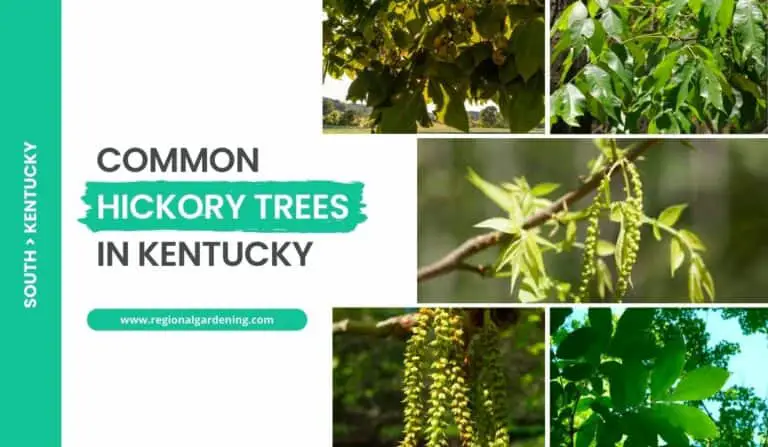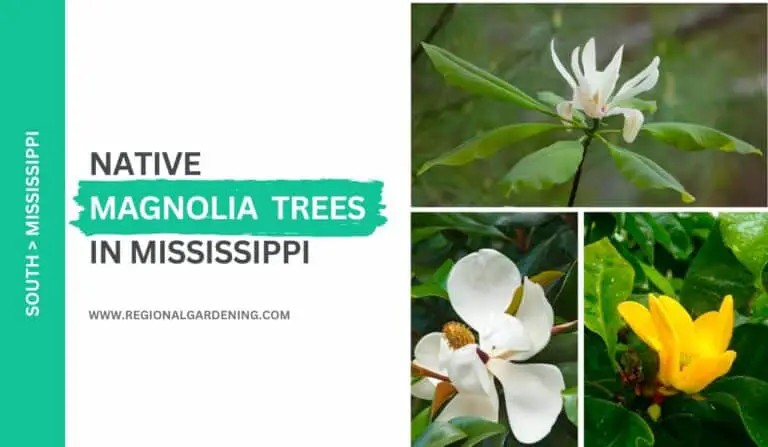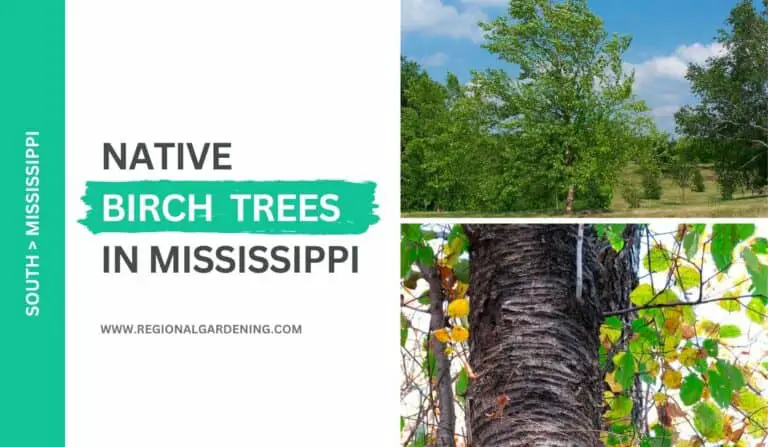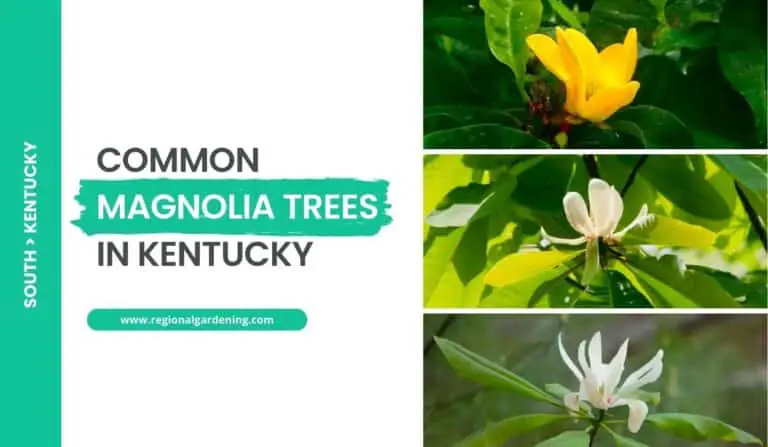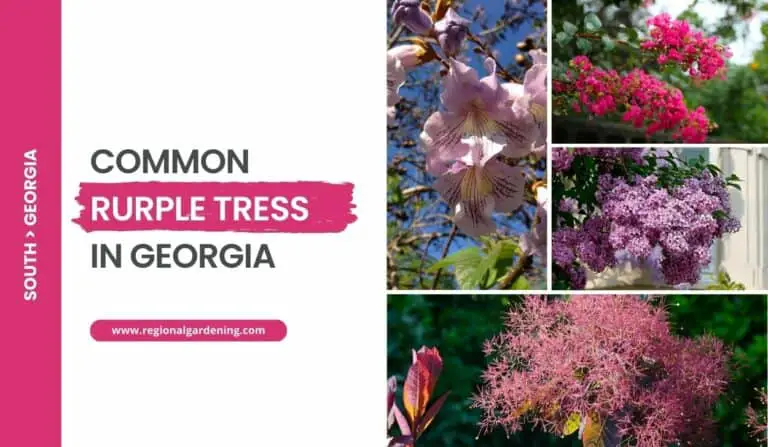10 Native Oak Trees In Kentucky (Photos & ID Guide)

The diverse landscape of Kentucky is adorned with a variety of oak species, each with distinct characteristics and ecological significance. We will look at these magnificent trees in this article, from the iconic White Oak with its broad canopy to the Scarlet Oak with its vibrant autumn foliage.
So, let’s begin with Black Oak, the most common among native oak trees in Kentucky.
1. Black Oak
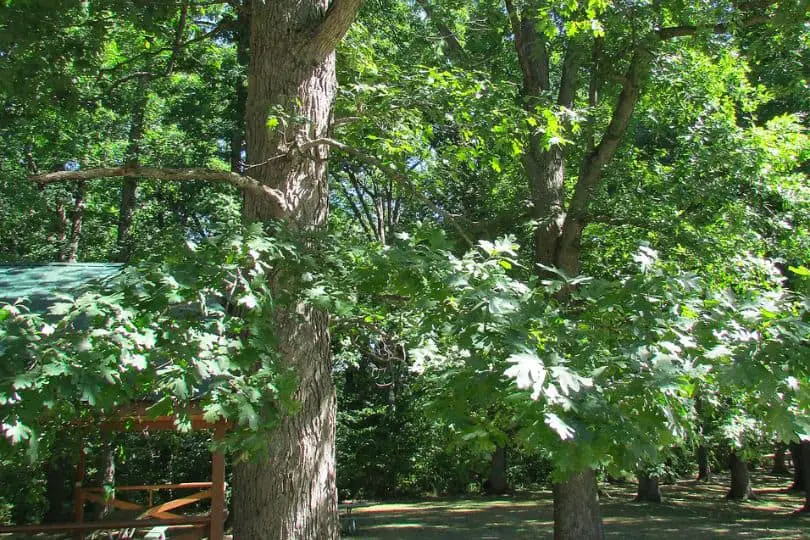
- Scientific Name: Quercus velutina
- Common Name(s): Black Oak
- Mature Height: 50 to 60 feet
- Native Region: Central and eastern North America, particularly in poor, dry soils
- Flowers: Inconspicuous female flowers; pendulous male catkins
- Fruit: ½- to 3/4-inch acorn coated with rust-colored down, enclosed in a cap
- Uses: The inner bark is used to make a yellow dye called quercitron.
The Black Oak (Quercus velutina) is a stately member of the red oak family endemic to central and eastern North America. This tree, which grows to a height of 50 to 60 feet, has lobed leaves that emerge in velvety red in the early spring.
The tree’s leaves turn bicolored as it ages, giving a stunning contrast to its distinctive black, furrowed bark. The foliage changes to orange or red in the fall, adding to its visual attractiveness.
Black oaks demand full sun and grow in well-drained, somewhat acidic soil. They are exceptionally hardy, withstanding poor and dry soil but not shade. One distinguishing trait is their prominent tap root, which aids with survival in difficult growth environments.
However, due to the vast root system, transplantation can be challenging. It is critical in Kentucky environments to minimize construction-related changes in the grade near the tree’s root system, as this can be detrimental to their health.
Female flowers are inconspicuous, and male catkins are pendulous. Its fruits are unusual, 12- to 3/4-inch acorns covered in rust-colored down and contained in caps. The inner bark of the Black Oak is used to make quercitron, a yellow dye that highlights the tree’s historical significance.
Black Oak trees in Kentucky gardens require plenty of sunlight and well-drained somewhat acidic soil. While they can endure dry circumstances, good drainage is essential. Regular monitoring for potential problems such as cryptic scale, bacterial leaf scorch, and oak horn gall is critical for the tree’s health. Furthermore, preventing grade changes near the root system is critical to the Black Oak’s lifespan and well-being in Kentucky environments.
2. Bur Oak
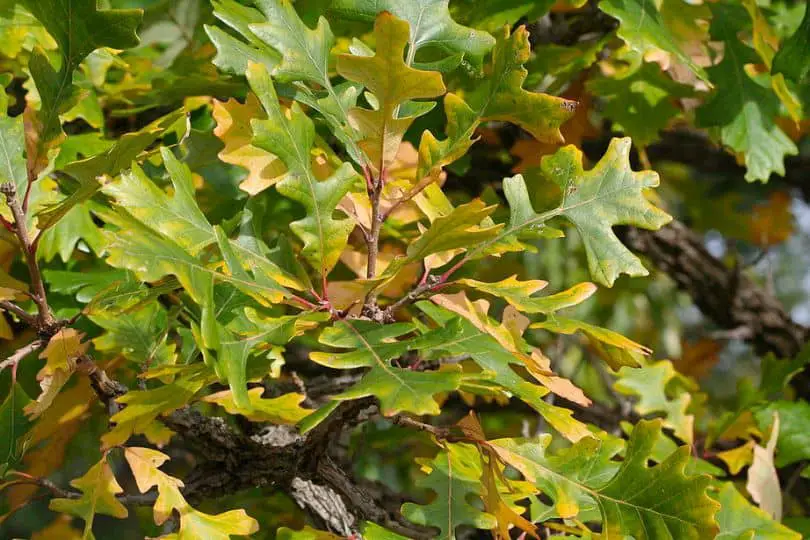
- Scientific Name: Quercus macrocarpa
- Common Name(s): Bur Oak
- Mature Height: 70 to 80 feet, can exceed 100 feet
- Native Region: Nova Scotia to Pennsylvania, west to Manitoba, and Texas
- Flowers: Inconspicuous female flowers, pendulous yellow-green male catkins
- Fruit: 3/4 to 1½-inch-long acorn half covered by a fringed cap
- Uses: Park tree, adaptable to urban conditions, landscape planting encouraged in Kentucky, historically common in the Bluegrass region
The Bur Oak, formally known as Quercus macrocarpa, is a stately member of the white oak group that thrives exceptionally well in Kentucky’s vast expanses, notably in the Bluegrass region.
This tree, distinguished by the distinctive fringed cup surrounding its acorns, is a testimony to endurance, with some individuals living for hundreds of years. It has big, lobed leaves and a rough, gray bark that becomes visible in the winter, making it a classic North American savanna tree.
The Bur Oak, which is native to rich bottomlands, is a remarkably adaptable tree with a large trunk and an uneven, open crown. It is a slow-growing tree that can reach heights of 70 to 80 feet and widths of more than 100 feet. The blossoms on the tree are understated, with modest female blooms and pendulous yellow-green male catkins. The acorn is its unique fruit, about 3/4 to 112 inches in length and half covered by a fringed cap.
The Bur Oak is cold-resilient and drought-tolerant and thrives best in full light. Its enormous root system, which is a mirror image of its above-ground structure, makes transplantation difficult. While the tree may suffer challenges such as cryptic scale and chestnut borer, it is often resistant.
Efforts are underway in Kentucky to encourage its planting in landscapes, since this once-common tree in the Bluegrass region is now a wonderful addition to Kentucky gardens, adding both historical and ecological value.
3. Chestnut Oak
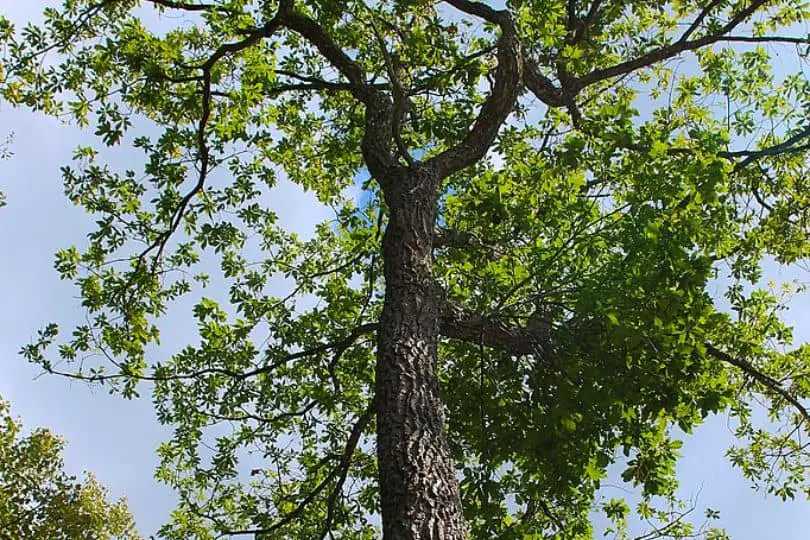
- Scientific Name: Quercus prinus
- Common Name(s): Chestnut Oak
- Mature Height: 60 to 70 feet
- Native Region: Rocky sites in the eastern U.S.; Kentucky native
- Flowers: Inconspicuous female flowers; pendulous male catkins
- Fruit: 1- to 1½-inch-long acorn, sweet enough to eat without boiling
- Uses: Shade tree for large areas; inner bark rich in tannic acid used for tanning; acorns serve as wildlife staple
The Chestnut Oak, scientifically known as Quercus prinus, is a hardy member of the white oak family notable for its chestnut-like leaves and ability to flourish in steep, rocky terrains where other oaks struggle.
This Kentucky native tree has an oval to rounded crown and can grow to heights of 60 to 70 feet. Its foliage begins in pink and progresses to silvery and then dark green. Chestnut Oak, known for its gorgeous silvery-white bark, is a favorite choice for big spaces, offering enough of shade in Kentucky gardens.
Chestnut Oak prefers full light and well-drained, dry soil as its environment. To avoid chlorosis or leaf yellowing, however, high pH conditions must be avoided. It is prone to concerns such as cryptic scale, chestnut borer, bacterial leaf scorch, oak horn gall, and gypsy moth, as do many other oaks. Surprisingly, the tap root of this oak renders it hard even in adverse situations.
The blossoms on the tree are understated, with modest female blooms and pendulous male catkins. The acorn, its fruit, is relatively enormous, measuring 1 to 112 inches in length, and is pleasant enough to eat without boiling. Chestnut Oak serves utilitarian reasons in addition to its aesthetic appeal. Its inner bark is high in tannic acid, making it important for tanning, and its acorns provide a food source for birds.
Chestnut Oak requires special care from Kentucky gardeners. It is critical to offer well-draining soil and plenty of sunlight while avoiding excessive pH levels. Because these robust trees are frequently left intact, proper attention during construction is required to prevent damage. Understanding and respecting the native habitat and development habits of the Chestnut Oak is essential for establishing a successful Chestnut Oak in Kentucky landscapes.
4. Chinkapin Oak
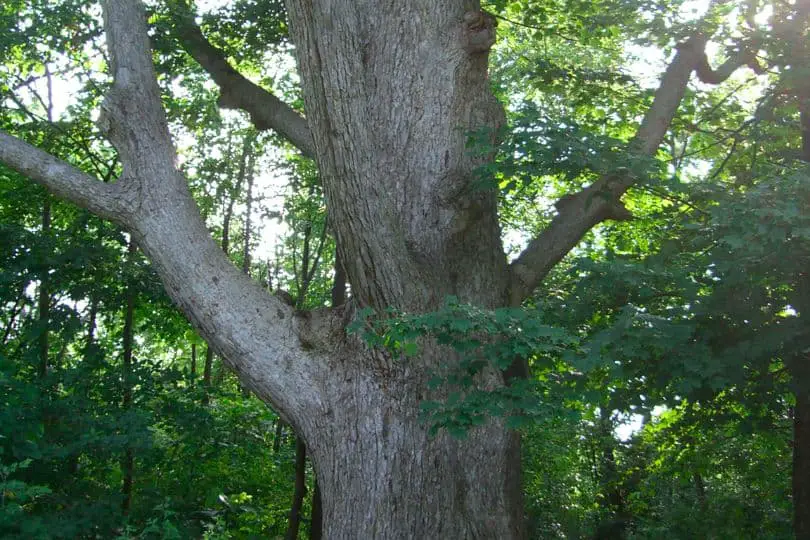
- Scientific Name: Quercus muehlenbergii
- Common Name(s): Chinkapin Oak
- Mature Height: 40 to 50 feet in gardens, 70 to 80 feet in the wild
- Native Region: New England to northeastern Mexico on limestone outcrops
- Flowers: Inconspicuous female flowers; pendulous male catkins
- Fruit: Small acorn, ¾ to 1 inch long, with a thin cap
- Uses: Wood for split-rail fences, railroad ties, and construction lumber; historically used as fuel for steamships along the Ohio River
The Chinkapin Oak (Quercus muehlenbergii) is a famous member of the white oak group, distinguished by its chestnut-like leaves. The Chinkapin Oak, unlike many white oaks, thrives in alkaline soils, making it a favorite in Kentucky gardens. Its pale bark and wide, rounded crown form a lovely silhouette, especially after the leaves have gone.
The tree can grow to heights of 40 to 50 feet in gardens and 70 to 80 feet in its natural habitat, which stretches from New England to northeastern Mexico on limestone outcrops.
The Chinkapin Oak’s leaves are yellow-green on top and pale on the bottom, swaying gently in the breeze. These leaves transition colors from yellow to brown in the fall, adding to their visual appeal. Female flowers are inconspicuous, and male catkins are pendulous. Its fruits are little acorns that range in size from three-quarters to one inch in length and are topped with a thin crown.
Historically, the Chinkapin Oak has been valued for its hardwood, which has been used to make split-rail fences, railroad ties, and building materials. Furthermore, it was once used to power steamships on the Ohio River. This oak type provides not only a visual joy in Kentucky gardens but also as a testament to historical significance.
Chinkapin Oaks like full sun and can adapt to a variety of soil conditions, including alkaline soils, unlike most white oaks, which suffer from chlorosis when exposed to high pH levels.
However, transplanting this species is difficult, and even a small amount of fill dirt might be harmful. The tree is alkaline soil tolerant and has a varied habit, making it a good option for oak breeding projects. These trees require specific attention in Kentucky landscapes to maintain their health and longevity, particularly during the transplanting period.
Understanding the natural range of the Chinkapin Oak aids in duplicating its perfect conditions. It prefers fertile ground with a high water table as its natural habitat. Unfortunately, because of these ideal conditions, it has been cleared for agricultural uses. As a result, providing well-draining soil and appropriate irrigation in gardens and landscapes can imitate its ideal environment, allowing it to thrive in Kentucky’s unique ecosystem.
5. Pin Oak
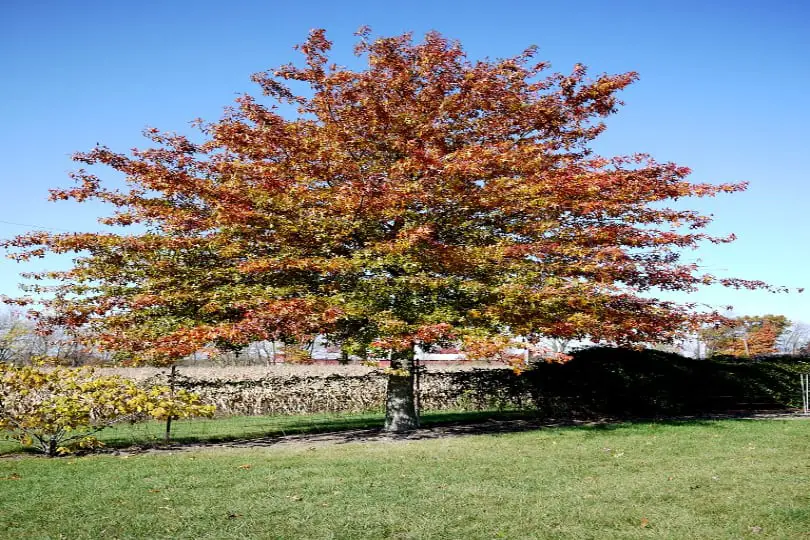
- Scientific Name: Quercus palustris
- Common Name(s): Pin Oak
- Mature Height: 60 to 70 feet tall, can reach over 100 feet
- Native Region: Massachusetts to Delaware, west to Wisconsin, and Arkansas
- Flowers: Brown and not showy
- Fruit: Nut, half an inch long and wide, light brown, enclosed at the base in a thin cap
- Uses: Widely used in parks, golf courses, lawns, and as a street tree. Commonly grown in large landscapes. Its wood, although full of knots, is used. Acorns are produced and are a food source for wildlife.
The Pin Oak (Quercus palustris) is a well-known tree in Kentucky gardens due to its unusual appearance. This oak is distinguished due to its unusual growth pattern, reaching heights of 60 to 70 feet and sometimes exceeding 100 feet.
Lower branches drop down elegantly, while intermediate branches are horizontal, and upper branches stand straight. The tree has glossy green foliage in the summer, which changes to russet, red, or bronze hues in the fall, adding to its visual attractiveness.
This oak species is native to the states of Massachusetts, Delaware, Wisconsin, and Arkansas. It grows well in moist, rich, acidic, well-drained soils, making it an excellent choice for Kentucky settings.
However, because it is vulnerable to iron chlorosis, galls, oak wilt, and bacterial leaf scorch, pin oak should be planted with caution in urban environments. Despite its cosmetic significance, pin oak confronts issues such as graft incompatibility in some cultivars, which can result in early death.
Pin oak yields little nuts wrapped in thin caps after flowering in brown, inconspicuous blossoms. Although there are many acorns, they are not the main attraction. Because of its slender limbs, the tree is attractive in parks, golf courses, and vast lawns. Its wood, despite being of poor quality due to knots, is useful. Furthermore, pin oak is an important food source for wildlife, emphasizing its ecological importance.
Pin oak takes special care for maximum development in Kentucky. It grows well in broad light and tolerates moisture, but difficulties in high-pH soils. Regular care, particularly in metropolitan areas, is required to maintain its health and vitality.
Proper planting procedures, as well as diversity in street tree species, will help to prevent any disease issues, extending the life of this majestic oak in Kentucky gardens.
6. Northern Red Oak
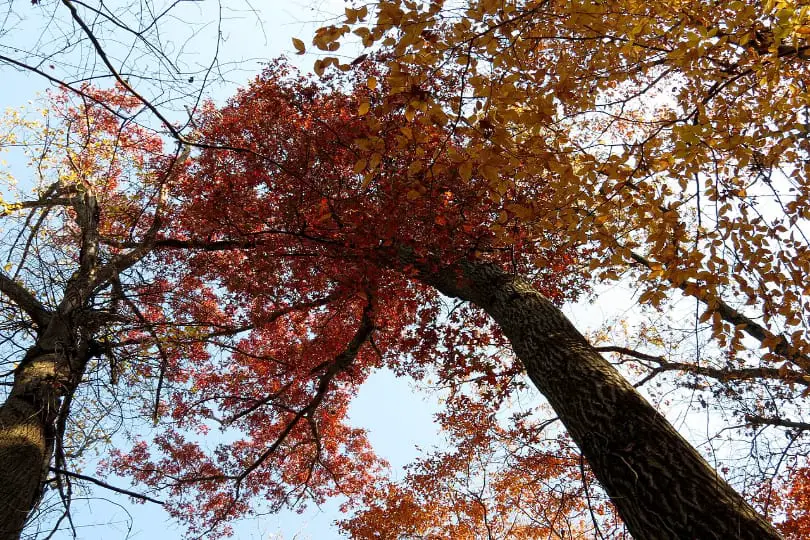
- Scientific Name: Quercus rubra
- Common Name(s): Red Oak
- Mature Height: 60 to 75 feet
- Native Region: Central and Eastern North America; throughout Kentucky
- Flowers: Inconspicuous female flowers; pendulous male catkins
- Fruit: Acorns, 3/4 to 1 inch long, covered by a shallow cap
- Uses: Timber production, ornamental tree, popular in Europe as well
Quercus rubra, sometimes known as Red Oak, is a resilient tree in the Red Oak family. It has lobed leaves and is found throughout North America, including all regions of Kentucky.
This tree is valued for its appealing branching pattern, lovely furrowed bark in the winter, and gorgeous red or brown fall color. Red Oak is a fast-growing tree with a dense, spherical crown that can reach heights of 60 to 75 feet.
It grows well in full sunlight and acidic, well-drained sandy loam soil. It is notable for being more resistant to air pollution yet vulnerable to chlorosis in high-pH soils.
Red Oak grows in mixed mesophytic woods in its natural habitat of central and eastern North America, including Kentucky. Its tiny female flowers and pendulous male catkins finally produce acorns 3/4 to 1 inch long with a shallow crown.
Because of its rapid growth and high wood quality, red oak is a desirable tree for timber production. Furthermore, it is a popular landscaping material in North America and Europe.
It is critical to have well-drained soil and full sun exposure while growing Red Oak in Kentucky gardens. Because of its tolerance to air pollution, red oak is excellent for urban environments, though caution should be exercised to avoid stress-related disorders such as chlorosis.
This species is sensitive to soil acidity and drainage. Furthermore, the spectacular beauty of Red Oak, combined with its flexibility, makes it a popular option among gardeners and landscapers in Kentucky and beyond.
7. Shingle Oak
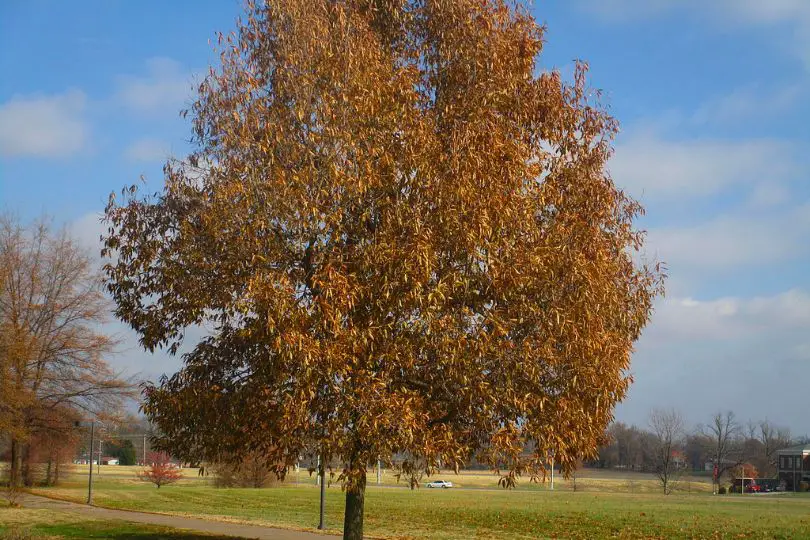
- Scientific Name: Quercus imbricaria
- Common Name(s): Shingle Oak
- Mature Height: 50 to 60 feet, up to 100 feet in the wild
- Native Region: Central and Eastern North America, including Kentucky
- Flowers: Female flowers in spikes; pendulous male catkins are yellow-green
- Fruit: Acorns, with the top half covered by a cap of reddish-brown scales
- Uses: Shingle oak makes a good park or street tree, adapts well to pruning, and is useful as a hedge. It was historically used to make shingles due to its strong wood.
Shingle oak, formally known as Quercus imbricaria, is a red oak species distinguished by willow-like leaves.
This tree is one of the most beautiful oaks, with dark green, glossy, willow-shaped leaves that lack lobes. Its name comes from its historical use: early North American immigrants used this tree to create shingles, hence the common name “shingle oak.”
The tree has an exquisite branching form and ridged bark, and it casts modest shade in summer. While the fall color isn’t very eye-catching, the glossy leaves remain appealing throughout the year.
The shingle oak, which is native to central and eastern North America, including Kentucky, flourishes in rich woodlands.
When young, it takes on a pyramidal shape before maturing into a wide-spreading tree with a height of 50 to 60 feet, and in the wild, it can reach towering heights of up to 100 feet. Female flowers are spiked, and male catkins are pendulous and yellow-green. Its acorns are 5/8 inch long and feature a crown of reddish-brown scales on the upper half.
It is relatively simple to grow shingle oak in Kentucky landscapes. It favors rich, moist, acidic soil and full sun, but it can also tolerate dryness, urban circumstances, and slightly alkaline soil. Because of its tough wood, shingle oak can endure trimming and is resistant to storm damage.
Although it has few major pest and disease problems, it is susceptible to cryptic scale, chestnut borer, bacterial leaf scorch, oak horn gall, and gypsy moth.
In conclusion, shingle oak is an important addition to Kentucky gardens because it is both visually beautiful and historically significant. Its tolerance to a variety of environments, combined with its gorgeous leaves and low maintenance requirements, make it a popular choice for the region’s parks, streets, and hedges.
8. Scarlet Oak

- Scientific Name: Quercus coccinea
- Common Name(s): Scarlet Oak
- Mature Height: 70 to 75 feet (up to 100 feet in the wild)
- Native Region: Maine south to Florida, west to Minnesota and Missouri
- Flowers: Not showy
- Fruit: 1-inch-long reddish-brown acorn enclosed in a deep cap
- Uses: Valued for ornamental purposes and fine wood; suitable as a lawn or park tree; less susceptible to chlorosis problems than pin oak.
Scarlet Oak (Quercus coccinea) is a red oak species known for its lobed leaves and admired for both its ornamental value and high-quality timber. Because of its year-round attractiveness and tolerance for alkaline soil, this tree stands out as a great alternative to pin oak.
The red oak matures to a rounded, open form in its natural environment, which stretches from Maine to Florida and westward to Minnesota and Missouri, reaching heights of 70 to 75 feet, with exceptional individuals rising to 100 feet.
The crimson oak’s leaves are distinguished by sharply pointed, coarsely serrated lobes. These leaves have a dramatic range of colors, ranging from bright red in early spring to dark lustrous green in summer and scarlet in the fall.
The tree’s acorns are around 1 inch long and reddish-brown, with deep crowns. Although its blossoms are not particularly prominent, the red oak’s foliage, delicate branching pattern, and practically black bark make it a remarkable addition to any landscape, even in winter.
Scarlet oak demands full sun and well-drained, acidic soil to thrive in Kentucky landscapes. When compared to pin oak, this species is less prone to chlorosis.
While scarlet oaks are susceptible to problems such as cryptic scale, chestnut borer, bacterial leaf scorch, oak horn gall, and gypsy moth, good management can decrease these risks.
Notably, scarlet oak transplantation is aided by its spreading lateral roots, making it easier to transplant than other oak species. It is crucial to note, however, that the tree is less tolerant of different settings, which contributes to its lower frequency in landscapes.
The scarlet oak’s remarkable features are highlighted in Kentucky, particularly in well-kept gardens and parks. Its striking leaf color, strong structure, and tolerance to local soil conditions make it an important contribution to the state’s horticultural environment.
9. White Oak

- Scientific Name: Quercus alba
- Common Name(s): White Oak
- Mature Height: 50 to 80 feet (can exceed 100 feet in the wild)
- Native Region: Central and Eastern North America; native to Kentucky
- Flowers: Inconspicuous female flowers; pendulous male catkins
- Fruit: 1-inch-long acorns with a scaly cap covering the top one-fourth
- Uses: White oak wood traditionally used for baskets and bourbon barrels
One of the most majestic oaks in the eastern deciduous forest is Quercus alba, sometimes known as White Oak. This towering tree has rose-colored leaves that unfurl in the spring before developing to a deep green. Its notable feature is its ash-colored bark, which gives rise to its name. The leaves change color in the fall, from brown to rich red, and they last through the winter.
The White Oak, which is native to Kentucky, thrives in full sun and well-drained acidic soil. Once planted, it is drought tolerant yet intolerant of alkaline or poorly drained soil. Its enormous, wide-spreading crown and vigorous tap root make it a landscape favorite, while its strong root system can make transplanting difficult. The wood of the tree is extremely valued; it has traditionally been used to make baskets and, more importantly, barrels used in aging whiskey.
The White Oak has modest female blooms and pendulous male catkins. Its one-inch-long acorns are tipped with scales, making them immediately identifiable. This oak species is vital to its ecology, supplying food and shelter to a variety of creatures. However, it is prone to bacterial leaf scorch and chestnut borer, both of which are frequent problems for oak trees in general.
White Oaks demand careful consideration of soil pH and drainage in Kentucky gardens. Proper maintenance, such as preventing root disturbances and keeping appropriate leaf litter, is critical for their survival. Despite transplanting obstacles, their beauty and utility make them a desirable addition to cultivated landscapes when space allows.
10. Willow Oak
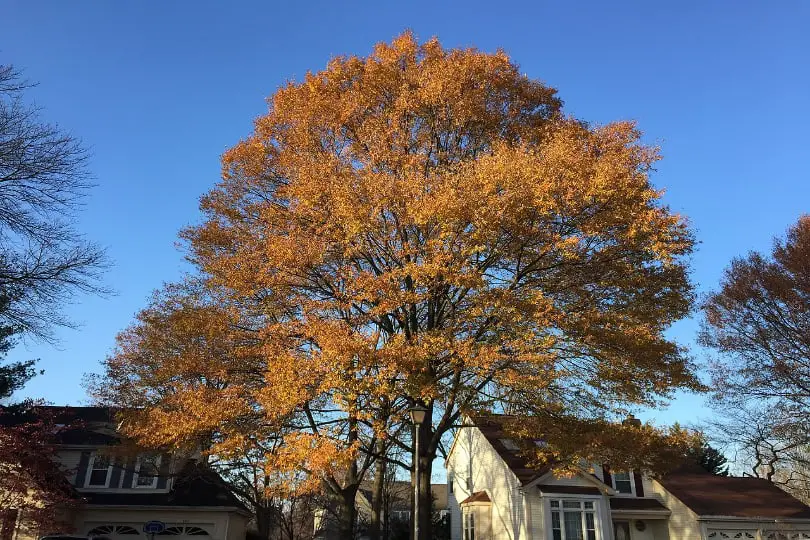
- Scientific Name: Quercus phellos
- Common Name(s): Willow Oak
- Mature Height: 40 to 60 feet
- Native Region: New York south to Florida, west to Texas, Oklahoma, and Missouri
- Flowers: Inconspicuous female flowers; pendulous male catkins
- Fruit: Small, ½-inch acorn topped by a shallow cap
- Uses: Excellent large shade tree, suitable for avenue plantings or large residences
Willow Oak (Quercus phellos) is a stately red oak tree distinguished by its willow-shaped leaves. One of its distinguishing characteristics is its fine leaves, which add texture and contrast with the coarseness of most other red oaks. This tree has a rounded shape, nice bark, and lovely winter characteristics. It is highly valued as a shade tree and is especially popular for large homes or avenue plantings.
Willow oak flourishes in moist, well-drained, acidic soil and demands full sun in regions ranging from New York to Florida and westward to Texas, Oklahoma, and Missouri. It is extremely versatile and can withstand pollution and drought, making it an ideal choice for gardeners. When it matures, its pyramidal growth habit changes to a rounded shape. The tree can grow to be 40 to 60 feet tall with a spread of 30 to 40 feet or more.
Willow oak has inconspicuous female flowers and pendulous male catkins in terms of reproduction. A shallow crown covers the tree’s little acorns, which are around half an inch in size. Its tall and narrow leaves emerge pale green in the spring, dark green in the summer, and yellow to russet-red in the fall. The bristly tips on the leaves add to the tree’s ornamental charm.
Willow oak is a hardy choice for Kentucky settings, as long as the soil pH remains acidic. It has a fibrous root system that makes it easy to transplant, and it is free of significant disease and insect concerns. Winter hardy to USDA Zone 5, it’s an excellent addition to Kentucky gardens, providing both visual beauty and beneficial shade.
Similar Articles
- Maple Trees In Kentucky
- Dogwood Trees In Kentucky
- Berry Trees In Kentucky
- Hickory Trees In Kentucky
- Ash Trees In Kentucky
- Cypress Trees In Kentucky
- Pine Trees In Kentucky
- Elm Trees In Kentucky
- Magnolia Trees In Kentucky
- Birch Trees In Kentucky
- Cedar Trees In Kentucky
- Locust Trees In Kentucky
Oak Trees In Kentucky – Sources
The Regional Gardening team makes sure that the information in our articles is accurate by only using sources that are known to be trustworthy. Some of these sources are peer-reviewed journals from government agencies, well-known universities, and scientific research organizations.
- Common Kentucky Trees, Department of Forestry & Natural Sources, University of Kentucky
- Native Trees Of Kentucky, Department of Horticulture, University of Kentucky.
- Trees & Shrubs of Kentucky, Book By Mary E. Wharton and Roger W. Barbour, University Press Of Kentucky


